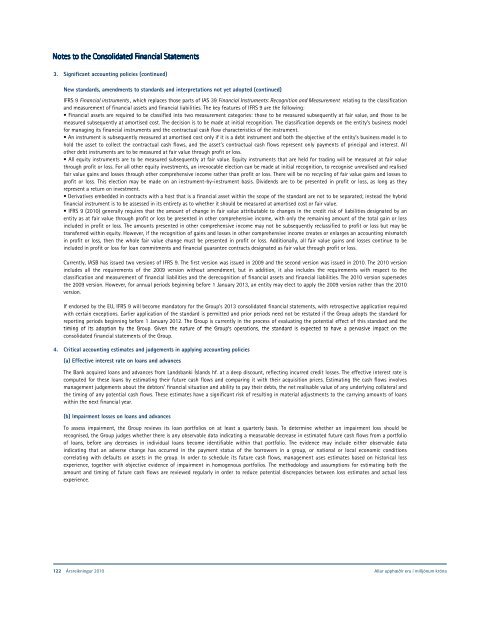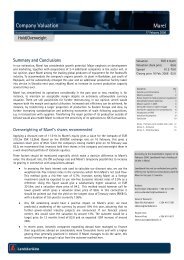Ársskýrsla Landsbankans - Landsbankinn
Ársskýrsla Landsbankans - Landsbankinn
Ársskýrsla Landsbankans - Landsbankinn
You also want an ePaper? Increase the reach of your titles
YUMPU automatically turns print PDFs into web optimized ePapers that Google loves.
Notes to the Consolidated Financial Statements<br />
3. Significant accounting policies (continued)<br />
New standards, amendments to standards and interpretations not yet adopted (continued)<br />
IFRS 9 Financial instruments , which replaces those parts of IAS 39 Financial Instruments: Recognition and Measurement relating to the classification<br />
and measurement of financial assets and financial liabilities. The key features of IFRS 9 are the following:<br />
• Financial assets are required to be classified into two measurement categories: those to be measured subsequently at fair value, and those to be<br />
measured subsequently at amortised cost. The decision is to be made at initial recognition. The classification depends on the entity’s business model<br />
for managing its financial instruments and the contractual cash flow characteristics of the instrument.<br />
• An instrument is subsequently measured at amortised cost only if it is a debt instrument and both the objective of the entity’s business model is to<br />
hold the asset to collect the contractual cash flows, and the asset’s contractual cash flows represent only payments of principal and interest. All<br />
other debt instruments are to be measured at fair value through profit or loss.<br />
• All equity instruments are to be measured subsequently at fair value. Equity instruments that are held for trading will be measured at fair value<br />
through profit or loss. For all other equity investments, an irrevocable election can be made at initial recognition, to recognise unrealised and realised<br />
fair value gains and losses through other comprehensive income rather than profit or loss. There will be no recycling of fair value gains and losses to<br />
profit or loss. This election may be made on an instrument-by-instrument basis. Dividends are to be presented in profit or loss, as long as they<br />
represent a return on investment.<br />
• Derivatives embedded in contracts with a host that is a financial asset within the scope of the standard are not to be separated; instead the hybrid<br />
financial instrument is to be assessed in its entirety as to whether it should be measured at amortised cost or fair value.<br />
• IFRS 9 (2010) generally requires that the amount of change in fair value attributable to changes in the credit risk of liabilities designated by an<br />
entity as at fair value through profit or loss be presented in other comprehensive income, with only the remaining amount of the total gain or loss<br />
included in profit or loss. The amounts presented in other comprehensive income may not be subsequently reclassified to profit or loss but may be<br />
transferred within equity. However, if the recognition of gains and losses in other comprehensive income creates or enlarges an accounting mismatch<br />
in profit or loss, then the whole fair value change must be presented in profit or loss. Additionally, all fair value gains and losses continue to be<br />
included in profit or loss for loan commitments and financial guarantee contracts designated as fair value through profit or loss.<br />
Currently, IASB has issued two versions of IFRS 9. The first version was issued in 2009 and the second version was issued in 2010. The 2010 version<br />
includes all the requirements of the 2009 version without amendment, but in addition, it also includes the requirements with respect to the<br />
classification and measurement of financial liabilities and the derecognition of financial assets and financial liabilities. The 2010 version supersedes<br />
the 2009 version. However, for annual periods beginning before 1 January 2013, an entity may elect to apply the 2009 version rather than the 2010<br />
version.<br />
If endorsed by the EU, IFRS 9 will become mandatory for the Group's 2013 consolidated financial statements, with retrospective application required<br />
with certain exceptions. Earlier application of the standard is permitted and prior periods need not be restated if the Group adopts the standard for<br />
reporting periods beginning before 1 January 2012. The Group is currently in the process of evaluating the potential effect of this standard and the<br />
timing of its adoption by the Group Group. Given the nature of the Group’s operations operations, the standard is expected to have a pervasive impact on the<br />
consolidated financial statements of the Group.<br />
4. Critical accounting estimates and judgements in applying accounting policies<br />
(a) Effective interest rate on loans and advances<br />
The Bank acquired loans and advances from Landsbanki Íslands hf. at a deep discount, reflecting incurred credit losses. The effective interest rate is<br />
computed for these loans by estimating their future cash flows and comparing it with their acquisition prices. Estimating the cash flows involves<br />
management judgements about the debtors' financial situation and ability to pay their debts, the net realisable value of any underlying collateral and<br />
the timing of any potential cash flows. These estimates have a significant risk of resulting in material adjustments to the carrying amounts of loans<br />
within the next financial year.<br />
(b) Impairment losses on loans and advances<br />
To assess impairment, the Group reviews its loan portfolios on at least a quarterly basis. To determine whether an impairment loss should be<br />
recognised, the Group judges whether there is any observable data indicating a measurable decrease in estimated future cash flows from a portfolio<br />
of loans, before any decreases in individual loans become identifiable within that portfolio. The evidence may include either observable data<br />
indicating that an adverse change has occurred in the payment status of the borrowers in a group, or national or local economic conditions<br />
correlating with defaults on assets in the group. In order to schedule its future cash flows, management uses estimates based on historical loss<br />
experience, together with objective evidence of impairment in homogenous portfolios. The methodology and assumptions for estimating both the<br />
amount and timing of future cash flows are reviewed regularly in order to reduce potential discrepancies between loss estimates and actual loss<br />
experience.<br />
NBI hf. Consolidated Financial Statements 2010 22<br />
All amounts are in ISK million<br />
122 Ársreikningur 2010 Allar upphæðir eru í milljónum króna



